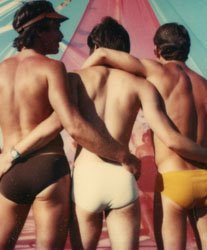Gay Sex in the 70s
 Joe and I went to see Joseph Lovett’s Gay Sex in the 70s tonight at the Coolidge Corner Theater in Brookline. The film takes a look at the sexual life of New York’s gay male subculture between Stonewall and the onset of the AIDS epidemic in 1981. Lovett neither condemns nor glamorizes 1970s gay New York. Instead, he strikes a delicate balance between portraying post-Stonewall sexual liberation as both a victory and a tragedy.
Joe and I went to see Joseph Lovett’s Gay Sex in the 70s tonight at the Coolidge Corner Theater in Brookline. The film takes a look at the sexual life of New York’s gay male subculture between Stonewall and the onset of the AIDS epidemic in 1981. Lovett neither condemns nor glamorizes 1970s gay New York. Instead, he strikes a delicate balance between portraying post-Stonewall sexual liberation as both a victory and a tragedy.Respondents shared wild stories of bars and bathhouses, dance floors and darkrooms, and lots and lots of public sex. Many of the respondents recounted the regular cruising and anonymous hookups that took place day and night at the dilapidated piers and abandoned warehouses off West Street along the Hudson River, a space that was virtually taken over by gay men. Like the baths, the piers and warehouses became a symbol of all the gains that had been achieved by Stonewall, namely sexual freedom and a space of their own.
I think that one thing the film demonstrates very clearly is that the gay liberation movement cannot be separated from the surge of sexual freedom that it ushered in. Still, it is difficult for me to fully appreciate the atmosphere of sexual freedom that pervaded the gay community of New York (and other places) in the 1970s because for me, it inevitably evokes what came later. I find myself having to resist the temptation to condemn the promiscuity of that age and its reckless self indulgence as having caused the AIDS epidemic. Rather, one must recognize that in the particular social context of post-Stonewall New York, AIDS was devastating.
At the same time, at least one respondent made the case that a byproduct of so much sex was the strong sense of community that developed and subsequently enabled the gay community to mobilize when its very existence was at stake in the 1980s. He argued that it was the shared experience of sexual liberation and the bonds formed in the bathhouse which provided the glue that held the gay community together. What Tom Hayden said about 1960s activism was especially true for post-Stonewall gay men: “The movement hangs together on the head of a penis.” The sex forged genuine human connections—even anonymous sex, through the sense of brotherhood it created.
Those of us who came of age in the era of “safe sex” may understand better than gay men in the 1970s that sex has real and sometimes deadly consequences, but we are far less liberated today. One could argue that we need to be in light of the threat of AIDS. I disagree. I believe that we need to be cautious and responsible, but these are not antithetical to being liberated. One can be genuinely liberated without being careless and irresponsible. Or put another way, one can be sensible, cautious, and responsible while still being enormously liberated sexually.
The film ends with a shot of the Hudson River waterfront looking out over the water past the old piles, now mere stumps sticking a few feet out of the water, where the piers and warehouses used to be. The image captures the changed physical landscape, but brilliantly symbolizes the changed cultural landscape. Lovett subtly suggests that the now gentrified and sanitized waterfront is arguably a more impoverished place.
As Joe and I left the theater and walked down Harvard Street toward our car, we bumped into a friend of ours. A male friend. A very cute male friend whom we find incredibly attractive. He’s also one of the smartest and most engaging guys we know, and we have found that such guys are usually the most fun in the bedroom.
The film’s respondents often reminisced about how after Stonewall, it was common day or night for a mere look—a casual glance as two men passed each other on the street—to lead to sex.
We exchanged pleasantries and went our separate ways. If only it were still the 70s.












2 Comments:
Yes, indeed. A friend of mine told me of a 30 minute (total) encounter with a guy in New York in the 70s. From start to finish the only words spoken were: "Wanna fuck?" [walk to apartment, sex, clean up]"See ya" "Bye."
An amazing time. And, yes--in gay life sex IS a bonding agent.
New York in the late 70's early 80's was so much fun, AIDS destroyed not just our most active generation, but our nostalgic past. I wish we could look back just once without the the filter of AIDS making everything so damn HEAVY!
Post a Comment
<< Home